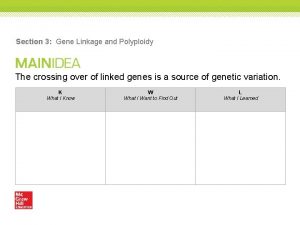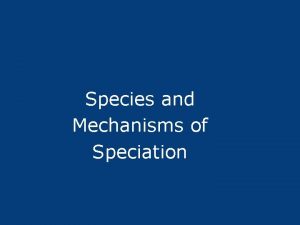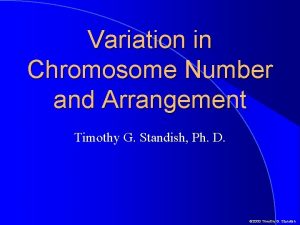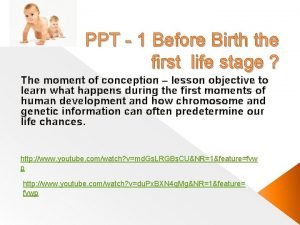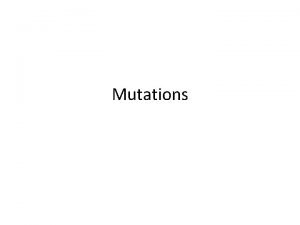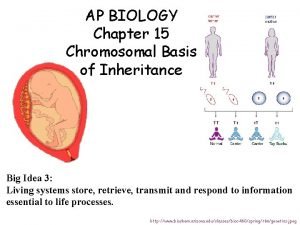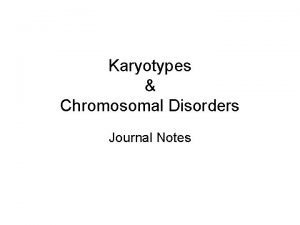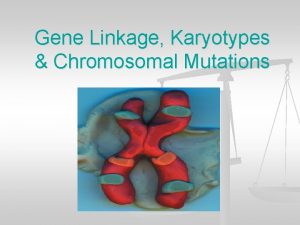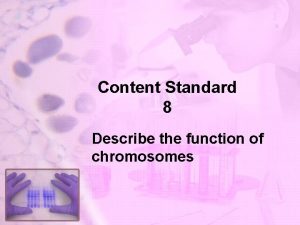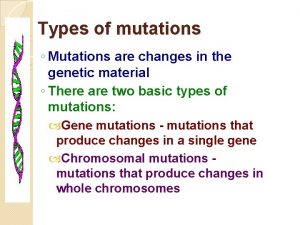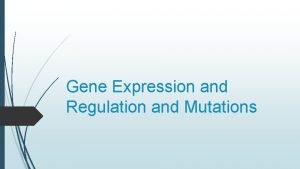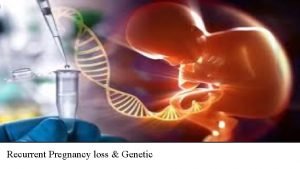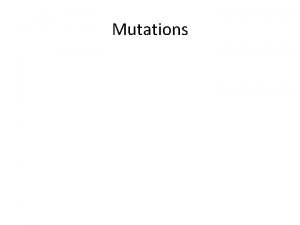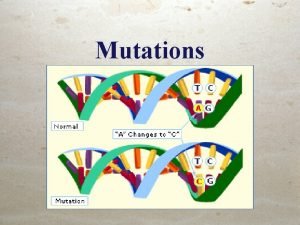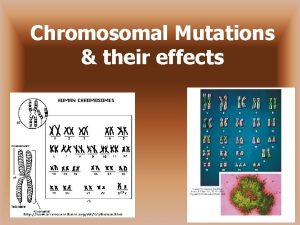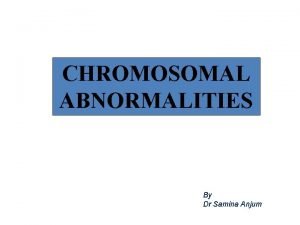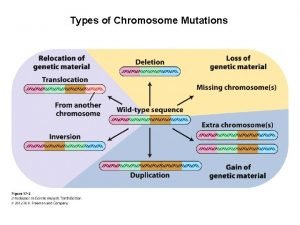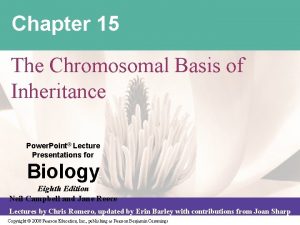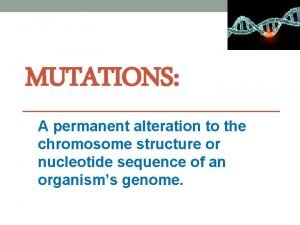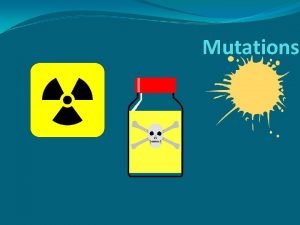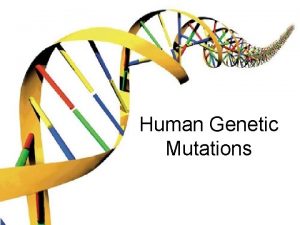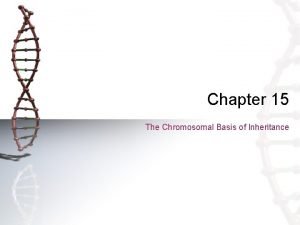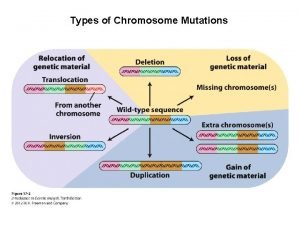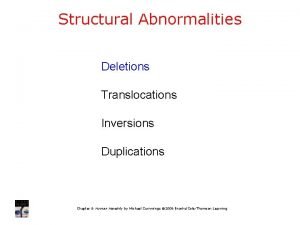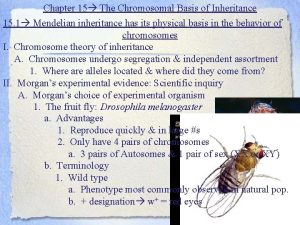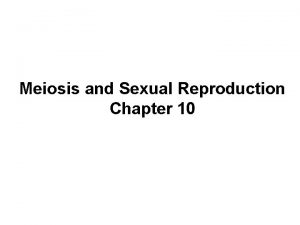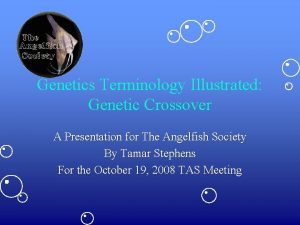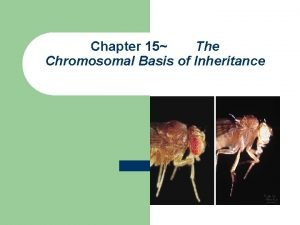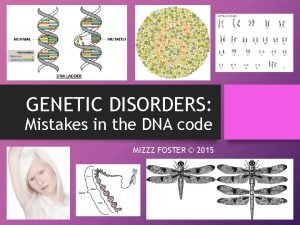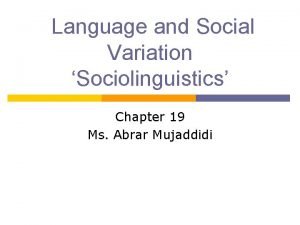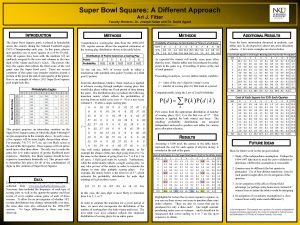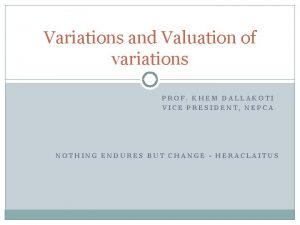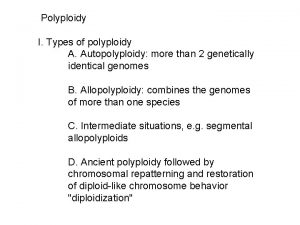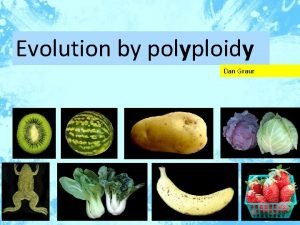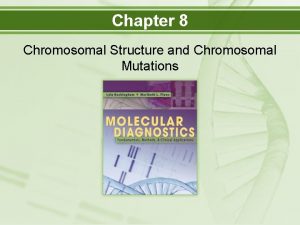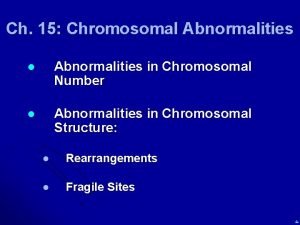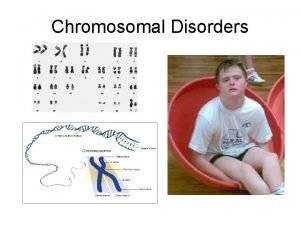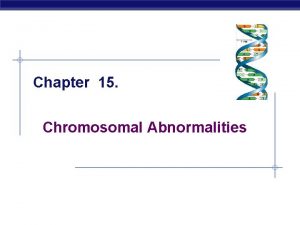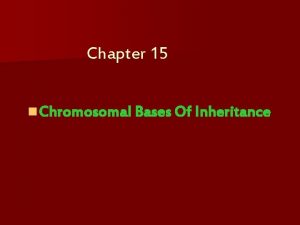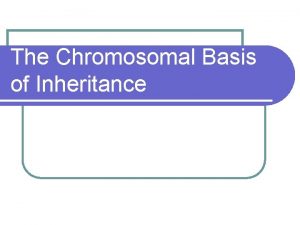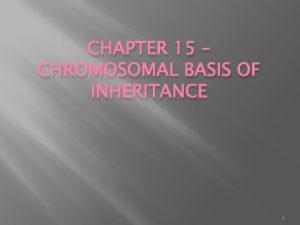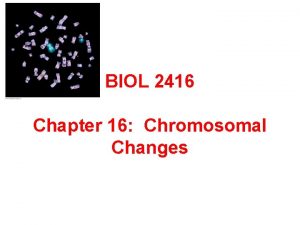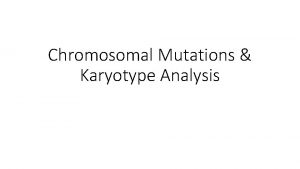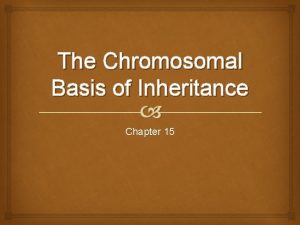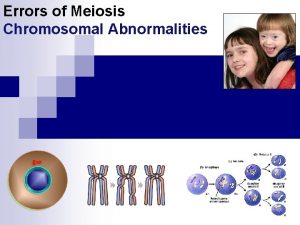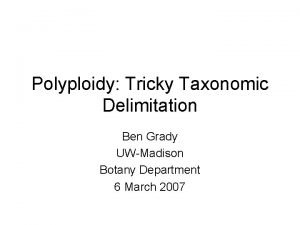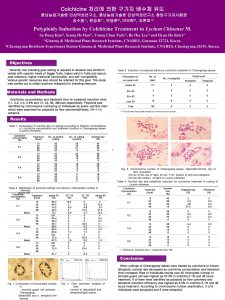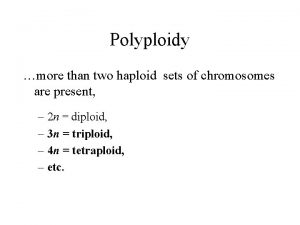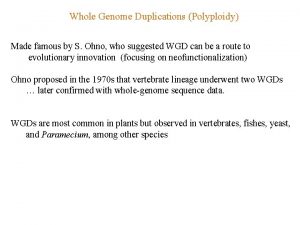Chromosomal Variations Overview I Chromosomal Variations A Polyploidy









































- Slides: 41

Chromosomal Variations

Overview I. Chromosomal Variations A. Polyploidy B. Aneuploidy II. Syndromes resulting from Aneuploidy A. Trisomy 13 B. Trisomy 18 C. Down Syndrome D. Turner Syndrome E. Klinefelter Syndrome F. XYY Syndrome

Variations in Chromosomal Number n n n Euploidy – the usual number and sets of chromosomes Polyploidy – the presence of three or more complete sets of chromosomes Aneuploidy – the presence of additional chromosomes or missing individual chromosomes

Types of Polyploidy n n Triploidy – three sets of chromosomes 23 x 3 = 69 Tetraploidy – four sets of chromosomes 23 x 4 = 92

Types of Aneuploidy n n Monosomy – one less chromosome (23 x 2) – 1 = 45 Trisomy – one additional chromosome (23 x 2) + 1 = 47

Aneuploidy n When aneuploidy occurs in humans, syndromes can result. Examples include the following: 1. 2. 3. 3. 4. 5. Trisomy 13 Trisomy 18 Down Syndrome Turner Syndrome Klinefelter Syndrome XYY Syndrome

Trisomy 13 n n Chromosomal Variation – Trisomy 13 (three copies of chromosome 13) Occurrence – 1 in 5000

Features of Trisomy 13 n n n Severe developmental delays Head and facial abnormalities Extra fingers and toes Kidney malformations Heart defects Early death

Trisomy 18 n n Chromosomal Variation – Trisomy 18 (three copies of chromosome 18) Occurrence – 1 in 5000

Features of Trisomy 18 n n n n Severe developmental delays Head and facial malformations Malformations of the hands and feet Skeletal malformations Kidney malformations Structural heart defects Early death

Down Syndrome n n Chromosomal Variation – Trisomy 21 (three copies of chromosome 21) Occurrence – 1 in 800 -1000

Features of Down Syndrome n n n n Low muscle tone Head and facial malformations Abnormalities of the extremities Developmental delays Heart malformations Increased risk of infectious disease Early death

Turner Syndrome n n Monosomy of sex chromosome (only one X chromosome present) Occurrence – 1 in 2500 live female births

Features of Turner Syndrome n n n Short stature Lack of ovarian development Neck abnormalities Skeletal disorders Increased risk of osteoporosis, cardiovascular constriction, diabetes, and kidney and thyroid problems

Klinefelter Syndrome n n Trisomy of sex chromosome - XXY (An additional X chromosome in males) Occurrence – 1 in 500 -1000 males

Features of Klinefelter Syndrome n n n Tall Sexually underdeveloped Infertility Sparse facial and body hair Developmental delays Increased risk of autoimmune disorders, breast cancer, osteoporosis, leg ulcers, depression, and dental problems

XYY Syndrome n n Trisomy of sex chromosome – XYY (An additional Y chromosome in males) Occurrence – 1 in 1000 -2000 men

Features of XYY Syndrome n n n n Taller Comparatively low weight relative to stature Larger craniofacial dimensions Severe acne in adolescence Behavior problems Learning disabilities Slightly lower IQ than normal

Conclusions n n Variations of chromosomal number involving a set of chromosomes (polyploidy) or an individual chromosome (aneuploidy) can occur Aneuploidy results in syndromes with distinct characteristics









POLYPLOIDY




POLYPLOIDY n n n A polyploid has more than 2 sets of chromosomes and is prevalent in plants but rare in animals. Many grass species are polyploid; some species can have more than 10 sets of chromosomes. Polyploidy occurs in some animals, such as goldfish, salmon, and salamanders, but is especially common among ferns and flowering plants, including both wild and cultivated species. Many grass species are polyploid. Wheat, for example, has strains that are diploid, tetraploid with the common name of durum or macaroni wheat, and hexaploid with the common name of bread wheat. The number of basic chromosomes sets (x) in a somatic cell determines the ploidy of the organism. If the different chromosomes set are complete - contain all the chromosomes - such an organism is referred to as a euploid.

Naming of polyploids n n Organism with 1 set of chromosomes (x) = monoploid Organism with 2 sets of chromosomes (2 x) = diploid Polyploids Organism Organism Etc. with with 3 4 5 6 7 sets sets of of of chromosomes chromosomes (3 x) (4 x) (5 x) (6 x) (7 x) = = = triploid tetraploid pentaploid hexaploid heptaploid

Classes of polyploids n n n Autopolyploids: Autopolyploids are polyploids of which all the sets of chromosomes have the same karyotype. If a set of chromosomes (also referred to as a genome) is represented by “A” then the genome compositions of a diploid and autopolyploids are: Diploid = AA Triploid = AAA (uneven polyploid) Tetraploid = AAAA (even polyploid) Pentaploid = AAAAA (uneven polyploid) In autopolyploids, a particular chromosome has the same number of homologous members as the ploidy: In triploids each chromosome occurs in groups of 3 homologues. In tetraploids each chromosome occurs in groups of 4 homologues. In pentaploids each chromosome occurs in groups of 5 homologues. Etc.

Allopolyploids n n Allopolyploids are polyploids of which the sets of chromosomes have different karyotypes. The chromosomes of the different genomes are also unable to synapse during meiosis, because of the extent of karyotypic differences between the genomes. Different letters of the alphabet is used to indicate alloploid genomes. Examples of allopolyploids: Triploid = AAB Tetraploid = AABB Pentaploid = AABBC



Segmental allopolyploids n n Segmental allopolyploids are polyploids of which the sets of chromosomes have different karyotypes. The chromosomes of the different genomes are able synapse during meiosis to varying degrees – depending on the extent of the karyotypic differences between the different genomes. The same letter of the alphabet is used to indicate segmental genomes, using sub- or superscripts to indicate that they are different. Examples of allopolyploids: Triploid = A 1 A 1 A 2 Tetraploid = A 1 A 1 A 2 A 2 Pentaploid = A 1 A 1 A 2 A 2 A 3

Characteristics of polyploids n • Polyploids tend to be larger than their diploid counterparts. They have larger cells with increased volume. • Polyploids tend to display semi-sterility or sterility. • Polyploid plants tend to display heightened susceptibility to frost damage and higher resistance to pests and pathogens. • Polyploid plants tend grow slower and flower later.

Chromosome numbers of some well-known species n n n Species Zygotic chromosome number 2 n Homo sapiens Zea maize Nicotiana tabacum Rosa canina Triticum aestivum 46 20 44 35 42 Basic chromosome number x 23 10 11 7 7 Ploidy Diploid (2 x) Tetraploid (4 x) Pentaploid (5 x) Hexaploid (6 x)

 Section 3 gene linkage and polyploidy
Section 3 gene linkage and polyploidy Chapter 10 section 3 gene linkage and polyploidy
Chapter 10 section 3 gene linkage and polyploidy Assortative
Assortative Number of chromosomes
Number of chromosomes Williams syndrome
Williams syndrome Chromosomal mutations
Chromosomal mutations Chapter 15 the chromosomal basis of inheritance
Chapter 15 the chromosomal basis of inheritance Difference between mendelian and chromosomal disorders
Difference between mendelian and chromosomal disorders Chromosome mutation
Chromosome mutation What function of
What function of What are some types of chromosomal mutations?
What are some types of chromosomal mutations? Types of mutations
Types of mutations Chromosomal abnormalities miscarriage
Chromosomal abnormalities miscarriage Chromosomal mutation
Chromosomal mutation Chromosomal mutation vs gene mutation
Chromosomal mutation vs gene mutation Incomplete abortion
Incomplete abortion Chromosomal mutation
Chromosomal mutation Chromosomal translocation
Chromosomal translocation Chromosomal mutation deletion
Chromosomal mutation deletion Chapter 15: the chromosomal basis of inheritance
Chapter 15: the chromosomal basis of inheritance A permanent alteration that changes a dna sequence
A permanent alteration that changes a dna sequence Celebrities with xyy syndrome
Celebrities with xyy syndrome Chromosomal abnormalities occur when a zygote's cells have
Chromosomal abnormalities occur when a zygote's cells have Substitution mutation
Substitution mutation Chapter 15: the chromosomal basis of inheritance
Chapter 15: the chromosomal basis of inheritance Deletion chromosomal mutation
Deletion chromosomal mutation Translocation
Translocation The chromosomal basis of inheritance chapter 15
The chromosomal basis of inheritance chapter 15 Chromosomal nondisjunction results in
Chromosomal nondisjunction results in Chromosomal crossover
Chromosomal crossover Chapter 15 the chromosomal basis of inheritance
Chapter 15 the chromosomal basis of inheritance Genetic disorders
Genetic disorders Example of two factor theory
Example of two factor theory Social variation in language
Social variation in language Kwl plus chart
Kwl plus chart Variations
Variations Possible variations
Possible variations Super bowl squares variations
Super bowl squares variations Valuation of variations
Valuation of variations Snow white male version
Snow white male version Sine rule obtuse angle
Sine rule obtuse angle Possible variations
Possible variations
